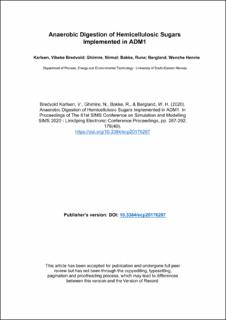| dc.contributor.author | Karlsen, Vibeke Bredvold | |
| dc.contributor.author | Ghimire, Nirmal | |
| dc.contributor.author | Bakke, Rune | |
| dc.contributor.author | Bergland, Wenche Hennie | |
| dc.date.accessioned | 2021-07-01T10:38:57Z | |
| dc.date.available | 2021-07-01T10:38:57Z | |
| dc.date.created | 2021-01-22T09:01:23Z | |
| dc.date.issued | 2020 | |
| dc.identifier.citation | Bredvold Karlsen, V., Ghimire, N., Bakke, R., & Bergland, W. H. (2020). Anaerobic Digestion of Hemicellulosic Sugars Implemented in ADM1. In Proceedings of The 61st SIMS Conference on Simulation and Modelling SIMS 2020 - Linköping Electronic Conference Proceedings, 176(40). | en_US |
| dc.identifier.issn | 1650-3686 | |
| dc.identifier.uri | https://hdl.handle.net/11250/2762760 | |
| dc.description.abstract | Lignocellulosic biomass is a sustainable and renewable source for both solids like biochar and biomethane by anaerobic digestion (AD). Hot water extraction (HWE) improves the total utilization of the biomass and produces a hydrolysate rich in hemicellulosic sugars with characteristics that needs to be understood. A study of the AD process in batch reactors with synthetic substrates composed of hemicellulosic sugars was performed and modelled using the standard IWA Anaerobic Digestion Model No. 1 (ADM1). Simulations were also performed using three strategies: 1) varying the stoichiometry for monosaccharide degradation, 2) varying the maximum uptake rate of the monosaccharide degrading organisms and 3) including a first order rate limiting step. The ADM1 model is a good tool but gave initially moderate agreement with the experimental results. The first two strategies did not improve the simulations but it improved significantly upon incorporating a rate limiting step, thereby simulating possible effects based on types of microorganisms present and diffusion limitations. | en_US |
| dc.language.iso | eng | en_US |
| dc.rights | Navngivelse-Ikkekommersiell 4.0 Internasjonal | * |
| dc.rights.uri | http://creativecommons.org/licenses/by-nc/4.0/deed.no | * |
| dc.title | Anaerobic Digestion of Hemicellulosic Sugars Implemented in ADM1 | en_US |
| dc.type | Peer reviewed | en_US |
| dc.type | Journal article | en_US |
| dc.description.version | acceptedVersion | en_US |
| dc.rights.holder | © The Author(s) 2020. | en_US |
| dc.source.volume | 176 | en_US |
| dc.source.journal | Linköping Electronic Conference Proceedings | en_US |
| dc.source.issue | 40 | en_US |
| dc.identifier.doi | https://doi.org/10.3384/ecp20176287 | |
| dc.identifier.cristin | 1876910 | |
| dc.relation.project | Norges forskningsråd: 269322 | en_US |
| cristin.ispublished | false | |
| cristin.fulltext | postprint | |
| cristin.qualitycode | 1 | |

